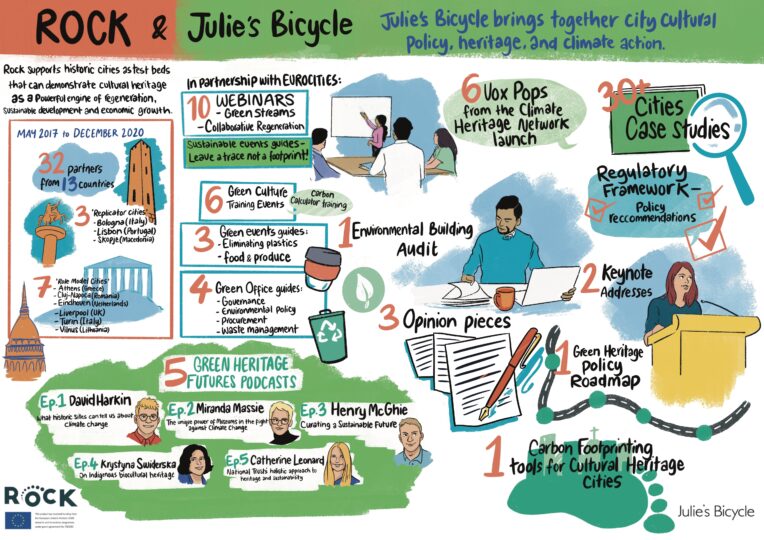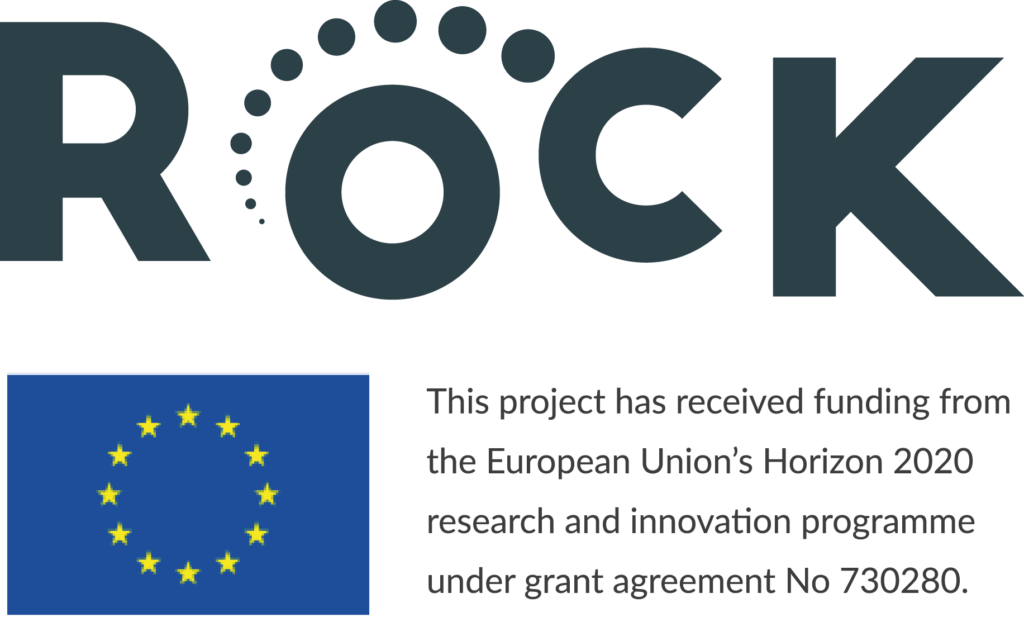- Posted on February 10th, 2021
ROCK Reflections: a European programme of culture-led action for sustainability

From 2018 to 2021, Julie’s Bicycle was one of the 32 partners in the EU Horizon 2020 ROCK project. JB’s Lucy Latham shares learnings from the programme and looks ahead to future pathways for connecting cultural heritage and environmental sustainability.
An Introduction to ROCK
The main objective of ROCK was to demonstrate how historic city centres could be used as laboratories, or test centres, for regeneration and sustainable urban development.
32 partners from 13 countries – including municipal governments, universities, SMEs and city networks – came together with the aim of developing an innovative, collaborative and systemic approach to regeneration and reuse within historic city centres.
Seven ‘Role Model’ cities from across Europe were selected for their unique knowledge economy structures and examples of good practice: Athens, Cluj-Napoca, Eindhoven, Liverpool, Lyon, Turin and Vilnius. The cities’ models of good practice were then tested in three ‘Replicator cities’: Bologna, Lisbon and Skopje.
How are environmental sustainability and cultural heritage linked?
“Climate change is the biggest threat to natural World Heritage sites.”
That’s the take-home message from the recent World Heritage Outlook 3 (2020) report from the International Union for Conservation of Nature (IUCN).
A third of natural World Heritage sites are threatened by climate change, and the number of sites where climate change is a ‘high’ or ‘very high’ threat nearly doubled in just three years, the report found.
The built environment is no exception. Heritage buildings, monuments and archaeological sites are also vulnerable to climate-related risks, from coastal erosion to flooding, as well as changing temperatures, fungal growth and insect infestations (Historic England).
This picture may look bleak, but the IUCN firmly believes that our valuable heritage sites can also form part of the solution. Heritage professionals have already trialled, developed and invested in carbon reduction measures within the built environment – as well as the restoration of traditional landscapes such as peatland, wetlands, and ancient woodlands – which all lock up carbon from the atmosphere.
Sustainability must be at the heart of heritage management, and heritage at the heart of sustainable development.
Our reflections and learnings from ROCK
ROCK recognises the urgent need for frameworks to support and encourage cultural heritage actors to take action on the environment, in order to safeguard heritage and protect society from the effects of environmental breakdown.
Julie’s Bicycle has worked closely with ROCK Replicator Cities, as well as project partners including EUROCITIES and ICLEI, to embed environmental knowledge, tools and skills within the heritage management ecosystem.
Over the past three years, our partnerships have achieved a lot – delivering environmental training and consultancy services, providing building and events audits, producing a new podcast and webinar programme, and providing policy and regulatory frameworks – all helping to embed sustainability within cultural heritage.
So what have we learnt?
1. Cultural and environmental objectives need to be clearly articulated and mutually-reinforcing.
In practice, this means cultural programmes referred to as “sustainable” must be underpinned by both a science-based decarbonisation strategy and social justice/just transition principles. Simultaneously, environmental policies and programmes need to be clear, specific and relevant to cultural heritage, recognising its unique qualities and capacity.
They must support the resilience of heritage sites via their financial management, good governance, and civic and community function; and ultimately protect cultural heritage sites for current and future generations.
2. Environmental policies need to be aligned and consistent vertically and horizontally across government levels, structures and departments.
Whether it’s within a region, city or organisation – environmental policies and strategies need to be consistent and reinforced vertically (e.g. international to local, political to administrative) and horizontally (across departments, covering economic, social, environmental and cultural thematic areas) so that policies are clear, aligned and coherent.
3. Policy and decision-makers need to ensure environmental action and adaption are supported through investment and capacity-building strategies.
The lack of dedicated financial support, as well as appropriate knowledge and skills, are commonly-cited barriers to engaging heritage managers with environmental action. Providing opportunities for training and access to resources will support cultural heritage in improving organisational resilience in the context of a changing climate – whilst helping them leverage development opportunities (improved resource efficiency, investment in infrastructure, community engagement etc.).
4. Policy needs to be developed through collaboration and co-production, empowering communities and supporting fit-for-purpose policy frameworks.
Governance is evolving from a state-centric system toward more open participatory systems with decision-making and budgets devolved to regions, cities and citizens. The policy-making process must be interdisciplinary and deliberative, empowering stakeholders and rights holders, including local communities and indigenous peoples, acknowledging interconnected social, cultural, environmental and economic domains.
Looking ahead
Safe-guarding cultural heritage for environmental purposes aims to protect not only natural heritage (including crucial habitats and biodiversity) – but also heritage as a driver for new and greener products, services, skills and finance, which can enhance the economic, social and cultural value that heritage brings.
Through all of this work, within and beyond ROCK, the heritage sector is flipping its role from a casualty of climate change to a catalyst for societal change. Yet, there is more that needs to be done, particularly in relation to cultural policy and investment – which provides the critical pathways to a truly sustainable sector. We must work together, invest in knowledge and capacity, and create the structures and platforms which will guide the transition of the heritage sector.
Cultural heritage shines a light on both the challenges and solutions of the past, and through that practical and embodied knowledge we can shape our definition of global ecological citizenship.
We change culture, culture changes the world.
Further information on ROCK funding
ROCK is one of the projects funded through Horizon 2020, the EU funding programme for research and innovation. A total fund of €66 million was provided for heritage-focused multi-national collaboration projects, as part of the 2018 ‘European Year of Cultural Heritage’. Through this title, the European Commission sought to ‘encourage the sharing and appreciation of Europe’s cultural heritage as a shared resource, to raise awareness of common history and values, and to reinforce a sense of belonging to a common European space.’
ROCK ran from May 2017 to April 2020. This project received funding from the European Union’s Horizon 2020 research and innovation programme, under grant agreement No 730280. Visit their website here.


Featured image: Graphic summary of ROCK created by Ada Jusic, 2020.
